5 Answers
The Story Behind the Remembrance Poppy
<caption>Field poppies growing near Connaught British Military cemetery on the old Western Front battlefields.</caption>

This is the story of how the red field poppy came to be known as an internationally recognized symbol of Remembrance.
From its association with poppies flowering in the spring of 1915 on the battlefields of Belgium, France and Gallipoli this vivid red flower has become synonymous with great loss of life in war.
Yet the scope of the poppy and its connection with the memory of those who have died in war has been expanded to help the living too. It was the inspiration and dedication of two women who promoted this same “Memorial Flower” as the means by which funds could be raised to support those in need of help, most especially servicemen and civilians suffering from physical and mental hardship as a result of war.
- Colour and Life in a Devastated Landscape
- Inspiration for the Flanders Fields Memorial Poppy
- Official Recognition of the Memorial Poppy
- Anna Guérin: “The French Poppy Lady”
- Spreading the Message of the Memorial Poppy
- Remembrance Poppies Made by War Veterans
- Poppies on the Old Battlefields
- The Poppy Umbrella: A Gift to Remember
Colour and Life in a Devastated Landscape
<caption>German soldiers carrying ladders through trenches in a smashed up wood on the Ypres Salient battlefield, 1915.</caption>
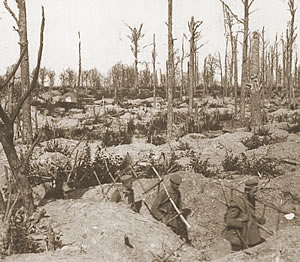
In the fighting zones the devastation caused to the landscape created a wasteland of churned up soil, smashed up woods, fields and streams. Few elements of the natural world could survive except for the soldiers who had little choice but to live in an underground network of holes, tunnels and trenches. In most cases the only living things they would see during tours of duty in the front line were scavenging rats, mice and lice.
James McConnell was an American pilot who had volunteered to fight in the war and was flying with the French Escadrille Lafayette. He recorded a vivid description of the destroyed landscape below him as he flew over the 1916 battlefield of Verdun. He describes the front line as a “brown belt, a strip of murdered Nature”:
“Immediately east and north of Verdun there lies a broad, brown band ... Peaceful fields and farms and villages adorned that landscape a few months ago - when there was no Battle of Verdun. Now there is only that sinister brown belt, a strip of murdered Nature. it seems to belong to another world. Every sign of humanity has been swept away. The woods and roads have vanished like chalk wiped from a blackboard; of the villages nothing remains but gray smears where stone walls have tumbled together... On the brown band the indentations are so closely interlocked that they blend into a confused mass of troubled earth. Of the trenches only broken, half-obliterated links are visible.” (1)
However, sometimes the sights and sounds of nature could be seen and heard through the fog of battle. Soldiers spoke of how birds, and most particularly the lark, could be heard twittering high in the sky even during the fury of an artillery bombardment.
New Life on the Battlefields
<caption>Poppies growing on the Somme battlefield near Thiepval in France.</caption>

Against the odds, new life did also occasionally come into being in the battle zones. A story about the birth of new human life happened during the surprise gas attack on the French lines by the German Army on 22nd April 1915. At exactly 5 o'clock, as the gas cloud was released, a Belgian woman gave birth to a baby boy in the cellar of a cottage on the Zonnebeekseweg, just 3 kilometres from the poisonous gas cloud and the battle that was going on as a result of it.(2)
The spring of 1915 was the first time that warm weather began to warm up the countryside after the cold winter at war in 1914-1915. In the region around Ypres in Belgian Flanders the months of April and May 1915 were unusually warm. Farmers were ploughing their fields close up to the front lines and new life was starting to grow. One of the plants that began to grow in clusters on and around the battle zones was the red field or corn poppy (it's species name is: papaver rhoeas). It is often to be found in or on the edges of fields where grain is grown.
The field poppy is an annual plant which flowers each year between about May and August. It's seeds are disseminated on the wind and can lie dormant in the ground for a long time. If the ground is disturbed from the early spring the seeds will germinate and the poppy flowers will grow.
This is what happened in parts of the front lines in Belgium and France. Once the ground was disturbed by the fighting, the poppy seeds lying in the ground began to germinate and grow during the warm weather in the spring and summer months of 1915, 1916, 1917 and 1918. The field poppy was also blooming in parts of the Turkish battlefields on the Gallipoli penninsular when the ANZAC and British Forces arrived at the start of the campaign in April 1915.
“In Flanders Fields the Poppies Blow...”

The sight of these delicate, vibrant red flowers growing on the shattered ground caught the attention of a Canadian soldier by the name of John McCrae. He noticed how they had sprung up in the disturbed ground of the burials around the artillery position he was in. It was during the warm days of early May 1915 when he found himself with his artillery brigade near to the Ypres-Yser canal. He is believed to have composed a poem following the death of a friend at that time. The first lines of the poem have become some of the most famous lines written in relation to the First World War.
In Flanders fields the poppies blow
Between the crosses, row on row,
That mark our place; and in the sky
The larks, still bravely singing, fly
Scarce heard amid the guns below.
In Flanders Fields by John McCrae
Inspiration for the Flanders Fields Memorial Poppy
<caption>Miss Moina Belle Michael (4)</caption>
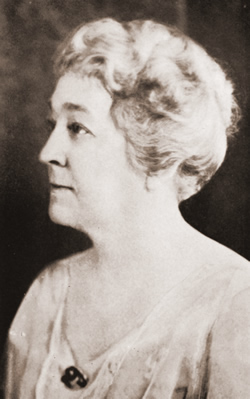
The origin of the red Flanders poppy as a modern-day symbol of Remembrance was the inspiration of an American woman, Miss Moina Michael.
Moina Michael: “The Poppy Lady”
It was on a Saturday morning, 9th November 1918, two days before the Armistice was declared at 11 o'clock on 11th November. Moina Belle Michael was on duty at the YMCA Overseas War Secretaries' headquarters in New York. She was working in the “Gemot” in Hamilton Hall. This was a reading room and a place where U.S. servicemen would often gather with friends and family to say their goodbyes before they went on overseas service.
On that day Hamilton Hall and the “Gemot” was busy with people coming and going. The Twenty-fifth Conference of the Overseas YMCA War Secretaries was in progress at the headquarters. During the first part of the morning as a young soldier passed by Moina's desk he left a copy of the latest November edition of the “Ladies Home Journal” on the desk.(3)
At about 10.30am Moina found a few moments to herself and browsed through the magazine. In it she came across a page which carried a vivid colour illustration with the poem entitled “We Shall Not Sleep”. This was an alternative name sometimes used for John McCrae's poem, which was also called “In Flanders Fields”. Lieutenant-Colonel John McCrae had died of pneumonia several months earlier on 28th January 1918.
<caption>A black and white reproduction of the colour illustration which was printed in the Ladies Home Journal which had such an impact on Moina Michael. (5)</caption>
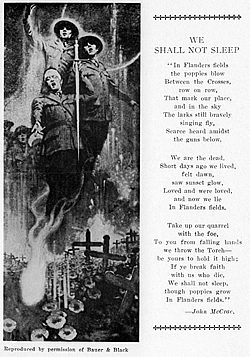
Moina had come across the poem before, but reading it on this occasion she found herself transfixed by the last verse:
Take up our quarrel with the foe:
To you from failing hands we throw
The torch; be yours to hold it high.
If ye break faith with us who die
We shall not sleep, though poppies grow
In Flanders fields.
In her autobiography, entitled “The Miracle Flower”, Moina describes this experience as deeply spiritual. She felt as though she was actually being called in person by the voices which had been silenced by death.
Moina Michael's Pledge to Keep the Faith
At that moment Moina made a personal pledge to “keep the faith”. She vowed always to wear a red poppy of Flanders Fields as a sign of remembrance. It would become an emblem for “keeping the faith with all who died”.
Compelled to make a note of this pledge she scribbled down a response on the back of a used envelope. She titled her poem "We Shall Keep the Faith". The first verse read like this:
Oh! you who sleep in Flanders Fields,
Sleep sweet - to rise anew!
We caught the torch you threw
And holding high, we keep the Faith
With All who died.
“We Shall Keep the Faith” by Moina Michael
Three men attending the conference then arrived at Moina's desk. On behalf of the delegates they asked her to accept a cheque for 10 dollars, in appreciation of the effort she had made to brighten up the place with flowers at her own expense.
She was touched by the gesture and replied that she would buy twenty-five red poppies with the money. She showed them the illustration for John McCrae's poem “In Flanders Fields” in the Ladies Home Journal, together with her response to it “We Shall Keep the Faith”. The delegates took both poems back into the Conference.
Poppies Worn in Remembrance

After searching the shops for some time that day Moina found one large and twenty-four small artificial red silk poppies in Wanamaker's department store. When she returned to duty at the YMCA Headquarters later that evening the delegates from the Conference crowded round her asking for poppies to wear. Keeping one poppy for her coat collar she gave out the rest of the poppies to the enthusiastic delegates.
According to Moina, this was the first group-effort asking for poppies to wear in memory of “all who died in Flanders Fields”. Since this group had given her the money with which to buy them, she considered that she made the first sale of the Flanders Fields Memorial Poppy on 9th November 1918.
Campaign for the Poppy as a National Memorial Symbol
Moina Michael was determined to put all her energy towards getting the Poppy emblem adopted in the United States as a national memorial symbol. She was encouraged by a positive reaction to the idea by the press.
She began a tireless campaign at her own expense, starting with a letter to her congressman in December 1918. In the letter she asked him to put the idea to the War Department, which he immediately did. She wanted to act swiftly so that this new national emblem might be already be produced in the form of pins, on postcards and so on in time for the signing of the peace treaty at Versailles in June 1919.
She realized that after the war the numerous signs related to the war - the Red Cross, War Loan insignia, Service Flags - which had been evident all over the United States during it's involvement in the war would gradually be removed. Moina considered that a replacement emblem, the red poppy, could be used to fill those empty spaces as a symbolic reminder of those who had not returned home to celebrate the end of the war.
Her religious upbringing inspired her to believe that the Flanders Memorial Poppy was indeed a spiritual symbol with more meaning behind it than pure sentimentalism. She likened the new optimism for a world returned to peace after the “war to end all wars” to the magnificent rainbow which appeared in the sky after the terrible flood in the bible.
The Torch and the Poppy Emblem
<caption>The Miracle Flower. Moina Michael's autobiography about the story of the Memorial Poppy.</caption>
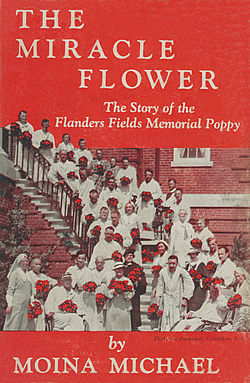
Originally Moina intended to use the simple red, four petalled field poppy of Flanders as the Memorial Poppy emblem.
Moina was put in touch with a designer, Mr Lee Keedick, who offered to design a national emblem under contract. In December 1918 he produced a final design, which was accepted. This emblem consisted of a border of blue on a white background with the Torch of Liberty and a Poppy entwined in the centre, containing the colours of the Allied flags: red, white, blue, black, green and yellow. The design appealed to Moina.
The “Torch and Poppy” emblem was first used officially on 14th February, 1919 in Carnegie Hall, New York City. The event was a lecture given by the Canadian ace pilot, Colonel William Avery “Billy” Bishop, VC, CB, DSO & Bar, MC DFC, ED. His lecture was titled “Air Fighting in Flanders Fields”. As the lecture ended a large flag with the new torch and poppy emblem on it was unfurled at the back of the stage.
However, in spite of the interest raised by the appearance of the new emblem at the time, and Moina's continued efforts to publicize the campaign, this emblem was not taken up by any group or individual to help establish it as a national symbol.
There was so little public interest in the enterprise that eventually the emblem's designer, Mr Keedick, abandoned his interest in pursuing Moina's campaign.
The Poppy and Help for Wounded Ex-Servicemen
During the winter of 1918/1919 Moina Michael continued working for the Staff of the Overseas YMCA Secretaries. She visited wounded and sick men from her home state of Georgia who were hospitalized in nine of the debarkation hospitals in and around New York City. She wanted to find what extra things she could do for them in addition to the medical care they were receiving.
By March 1919 she had moved back to Georgia to take up her place at the University of Georgia. With the return of thousands of ex-servicemen to the state Moina realised that there was not only a need to honour the memory of those who had died in the service of their country, but also a need to remember that those who were returning also had mental, physical and spiritual needs.
During the summer months of 1919 Moina taught a class of disabled servicemen. There were several hundred ex-servicemen in rehabilitation at the University of Georgia. Learning about their needs at first hand gave her the impetus to widen the scope of the Memorial Poppy idea. She thought it could be developed so that it could be used to help all servicemen who needed help for themselves and for their dependants.
Official Recognition of the Memorial Poppy
<caption>In 1983 a WW1 veteran, the late Tom Price, lays a poppy wreath at the grave of a comrade killed on the Somme battlefield in July 1916.</caption>
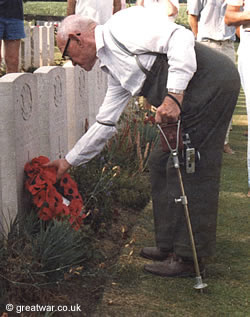
By 1920 Moina Michael was beginning to lose hope that the Memorial Poppy idea would ever come to fruition. She was in a dilemma about whether to pursue her own academic career or whether to abandon it in order to devote herself entirely to the Memorial Poppy campaign. However, in the early 1920s a number of organizations did adopt the red poppy as a result of Moina's dedicated campaign.
1920: The American Legion Adopts the Memorial Poppy
In 1919 the American Legion was founded as an organization by veterans of the United States armed forces to support those who had served in wartime in Europe during the First World War.
In August 1920 Moina discovered by chance that the Georgia Department of the American Legion was to convene on 20th of that month in Atlanta. Prior to the convention she searched out the delegates and the Navy representative promised to present her case for the Memorial Poppy to the convention.
The Georgia Convention subsequently adopted the Memorial Poppy but omitted the Torch symbol. The Convention also agreed to endorse the movement to have the Poppy adopted by the National American Legion and resolved to urge each member of the American Legion in Georgia to wear a red poppy annually on 11th November.
One month later, on 29th September 1920, the National American Legion convened in Cleveland. The Convention agreed on the use of the Flanders Fields Memorial Poppy as the United States' national emblem of Remembrance.
Anna Guérin: “The French Poppy Lady”
<caption>One of the first fabric poppies sold in the United Kingdom by the British Legion in aid of The Haig Fund.</caption>

Fund Raising for France with Poppies
A French woman by the name of Madame Anna E Guérin was present at the 29thSeptember National American Legion convention. Anna was a representative of the French YMCA Secretariat. Anna considered that artificial poppies could be made and sold as a way of raising money for the benefit of the French people, especially the orphaned children, who were suffering as a result of the war.
She was the founder of the “American and French Children's League” through which she organized French women, children and war veterans to make artificial poppies out of cloth. Her intention was that these poppies would be sold and the proceeds could be used to help fund the restoration of the war-torn regions of France.
Anna was determined to introduce the idea of the memorial poppy to the nations which had been Allied with France during the First World War. During 1921 she made visits or sent representatives to America, Australia, Britain, Canada and New Zealand.
Life and Work of Anna Guérin
A website released in November 2015 is devoted to Anna and her work with the poppy and Remembrance. This has been researched by Heather Johnson and provides a previously unknown insight into the part played by Anna in the story of the Remembrance Poppy. You can visit the website at:
Website: poppyladymadameguerin.wordpress.com
Spreading the Message of the Memorial Poppy
1921: French Poppies Sold in America
In 1921 Madame Guérin made arrangements for the first nationwide distribution across America of poppies made in France by the American and French Childrens' League. The funds raised from this venture went directly to the League to help with rehabilitation and resettlement of the areas of France devastated by the First World War. Millions of these French-made artificial poppies were sold in America between 1920 and 1924.
5th July 1921: Canada adopts the Flower of Remembrance
Madame Anna Guérin travelled to Canada, where she met with representatives of the Great War Veterans Association of Canada. This organization later became the Royal Canadian Legion. The Great War Veterans Association adopted the poppy as its national flower of Remembrance on 5th July 1921.
11th November 1921: The First British Legion Poppy Day Appeal
<caption>A modern Royal British Legion poppy. Originally bearing the words HAIG FUND, the black centre now bears the words “POPPY APPEAL”.</caption>

In 1921 Anna Guérin sent some French women to London to sell their artificial red poppies. This was the first introduction to the British people of Moina Michael's idea of the Memorial Poppy. Madame Guérin went in person to visit Field Marshal Earl Douglas Haig, founder and President of The British Legion. She persuaded him to adopt the Flanders Poppy as an emblem for The Legion. This was formalized in the autumn of 1921.
The first British Poppy Day Appeal was launched that year, in the run up to 11thNovember 1921. It was the third anniversary of the Armistice to end the Great War. Proceeds from the sale of artificial French-made poppies were given to ex-servicemen in need of welfare and financial support.
Since that time the red poppy has been sold each year by The British Legion(6) from mid October to to raise funds in support of the organization's charitable work.
11th November 1921: Armistice Day Remembrance in Australia
<caption>An Australian serviceman with a spray of poppies at the grave of an unknown Australian soldier at Polygon Wood cemetery, Ypres, on 11 November 2002.</caption>
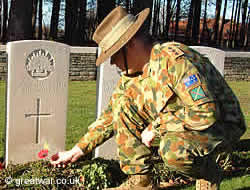
A resolution was passed in Australia that from 11th November 1921 the red Memorial Poppy was to be worn on Armistice Day in Australia.
The American and French Childrens' League sent a million artificial poppies to Australia for the 1921 Armistice Day commemoration. The Returned Soldiers and Sailors Imperial League sold poppies before 11th November. A poppy was sold for one shilling each. Of this, five pennies were donated to a French childrens' charity, six pennies were donated to the Returned Soldiers and Sailors Imperial League and one penny was received by the government.
Since that time red poppies have been worn on the anniversary of Armistice in Australia, officially named Remembrance Day since 1977. Poppy wreaths are also laid in Australia on the day of national commemoration called ANZAC DAY on 25th April. This is the day when the ANZAC Force landed on the beaches of the Gallipoli penninsular at the start of that campaign on 25th April 1915.
24th April 1922: The First Poppy Day in New Zealand
In September 1921 a representative from Madame Guérin visited the New Zealand veterans' association, called the New Zealand Returned Soldiers' Association (NZRSA) at that time. This organization had been established in 1916 by returning wounded veterans.
With the aim of distributing poppies in advance of the anniversary of Armistice Day on 11th November that year, the NZRSA placed an order for 350,000 small and 16,000 large French-made poppies from the French and American Childrens' League. Unfortunately the delivery of the poppies did not arrive in time to organize and publicize the first nationwide poppy campaign, the Association decided to hold the first Poppy Day on 24th April, the day before ANZAC Day, in the following year.
The first Poppy Day in New Zealand in 1922 raised funds of over £13,000. A proportion of this was sent to the French and American Childrens' League and the remainder was used by the Association for support and welfare of returned soldiers in New Zealand.
May 1922: French-made Poppies Sold in the United States
In 1922 the organization of the American and French Childrens' League was disbanded. Madam Guérin was still keen to raise funds for the French people who had suffered the destruction of their communities. She asked the American organization called Veterans of Foreign Wars (VFW) to help her with the distribution of her French-made poppies throughout the United States.
That year the VFW assisted with the sale of the poppies in America to help keep up the much needed funds for the battle-scarred areas of France. The poppies were sold before Memorial Day which was observed at that time on 30th May. This was the first time that a United States war veterans' organization took on the task of selling the red poppy as a symbol of Remembrance and as a means of fund raising. The VFW decided to adopt the poppy as its own official memorial flower.
1923: The American Legion Sells Poppies in the United States
In 1923 the American Legion sold poppies in the United States which were made by a French company.
Remembrance Poppies Made by War Veterans
American Legion Auxiliary Pays for Poppies
The Auxiliary to the American Legion was an organization founded in 1919 to support The American Legion. It was for women who wanted to devote their voluntary services to veterans and young people. The first convention of the Auxiliary took place in September 1921 and delegates agreed to adopt the red poppy as the memorial flower for the organization.
The delegates at the convention also agreed that disabled American war veterans could make their own poppies to be sold within the United States. The Auxiliary believed that US veterans making their own poppies could generate much needed income for disabled and unemployed veterans who had no other means of earning money. The Auxiliary provided all the material for the artificial poppies and had it pre-cut to form easily into individual flowers. The Auxiliary paid a penny for each poppy that was made.
Moina Michael was very pleased with this development. According to her there was a feeling in America that so many returning servicemen did not have jobs and that they could themselves benefit from making and selling poppies. These men had done their bit for France and now they needed to provide food, shelter and clothing for their own families.(7)
The American Legion Auxiliary continues its work to support veterans and promotes the wearing of a red poppy on the annual Memorial Day observed in May in the United States. Paper poppies are handmade by veterans who are paid for them.
The Buddy Poppy Factory, U.S.A.
Following the distribution of the red French-made poppies for Madame Guérin in 1922, the Veterans of Foreign Wars (VFW) organization formally agreed in 1923 that American veterans of the Great War could also benefit from making and selling the red Memorial Poppy.
From 1924 disabled ex-servicemen started making poppies at the “Buddy Poppy” factory in Pittsburgh. The name “Buddy Poppy” was registered as a U.S. Patent in February 1924. In the following May a certificate was issued to grant trademark rights to the VWF for the manufacture of genuine “Buddy Poppies”.
Since the 1920s the “Buddy Poppy” program has continued to raise money for the welfare and support of veterans and their dependants. There are now 11 locations where the “Buddy Poppies” are made by disabled and needy veterans. Some 14 million “Buddy Poppies” are distributed each year in the United States.
Founding of The Poppy Factory in England
<caption>British poppy wreaths made by The Poppy Factory. (Menin Gate Memorial in Ypres, November 2005.)</caption>
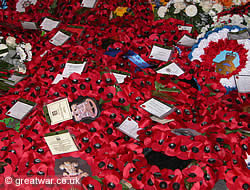
In 1922 the Poppy Factory was established in the Old Kent Road, south London. It was the idea of Major George Howson MC, founder of The Disabled Society for disabled ex-servicemen and women. By making artificial poppies for sale around the anniversary of the 1918 Armistice, the Poppy Factory could employ five disabled men during the year.
In 1933 the demand for poppies for Poppy Day was such that the Poppy Factory had to move to larger premises in Richmond, Surrey. The demand for poppies continued to grow each year.
Nowadays the Poppy Factory is producing nearly 40 million poppies for wreaths, sprays and buttonholes.
The Lady Haig Poppy Factory, Scotland
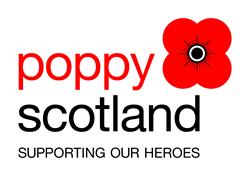
The Earl Haig Fund Scotland was set up as a Scottish charity in 1921 by its founder Field Marshal Earl Douglas Haig. In 1926 Countess Dorothy Haig, wife of Earl Haig, founded the Poppy Factory in Edinburgh. Earl Haig had been born in Edinburgh.
The charity now trades by the name of Poppyscotland, based in Edinburgh. It continues to raise funds for the Scottish Poppy Appeal, supporting veterans and their dependants in Scotland. The Lady Haig Poppy Factory produces over four million poppies each year. Approximately 30 veterans with disabilities are employed at the Factory.
Canadian Veterans and Remembrance Poppies
<caption>Modern Canadian poppy wreath at the Menin Gate Memorial, Ypres, November 2005.</caption>

From 1922 disabled Canadian war veterans made the lapel poppies that were sold in Canada. This was carried out with sponsorship from the Canadian government Department of Soldiers Civil Re-establishment. From 1966 the operation was moved to the workshops of the Veterans' Affairs Canada, called Vetcraft, in Montreal.
More recently the Royal Canadian Legion has taken over the task of producing the poppies for Remembrance Day. The poppies are now made by a company under the guidelines of the Royal Canadian Legion.
Making the New Zealand Poppies
The poppies for Poppy Day distributed by the New Zealand Returned Soldiers' Association (NZRSA) were obtained from the French Childrens' League until 1927. For the next three years they were ordered from the Poppy Factory in Richmond, England. It was in 1931 that the NZRSA established a scheme in Auckland and Christchurch so that disabled veterans could make the poppies themselves. At the end of the Second World War the number of poppies distributed in New Zealand had grown to approximately 750,000.(8)
The design of the poppy was changed in 1978 to that of the “Earl Haig poppy” as produced by the Royal British Legion. The Christchurch RSA is now responsible for the production of all the poppies made for Poppy Day in New Zealand.
Poppies on the Old Battlefields
<caption>Poppies on the Somme battlefield at Thiepval.</caption>

Nowadays poppies still bloom on the old 1914-1918 battlefields of northern France and Belgium. However, visitors expecting to see fields of poppies will quite likely be disappointed. The idea of fields full of poppies is possibly a misconstrued image from the lines of John McCrae's poem "In Flanders fields the poppies blow". More likely the line refers to clusters of poppies growing in the fields and especially around the graves in the disturbed ground of the poem. Due to the nature of farming today the poppies blooming in the battlefield areas do tend to be found in small clusters rather than in whole fields. The affects of the weather can also provide a better show of flowering poppies in one year more than another.
The Poppy Umbrella: A Gift to Remember
Founded by the family behind this website, the design of The Poppy Umbrella was inspired by the powerful image of poppies in John McCrae's poem “In Flanders Fields”. This unique umbrella was created by Lieutenant Colonel Graham Parker, OBE, as an innovative and practical way to “Uphold the Memory”. Sales of The Poppy Umbrella help to raise funds for Service related welfare charities and military heritage organizations.
The Poppy Umbrella
Related Topics
<caption>John McCrae, author of the poem “In Flanders Fields”</caption>
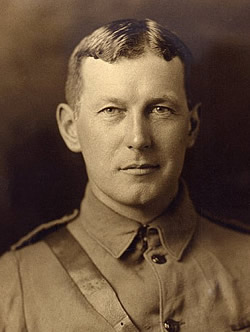
“In Flanders Fields” poem by John McCrae
Inspiration for “In Flanders Fields”
Moina Belle Michael: Biography
Related Links
Madame Anna Guérin, The French Poppy Lady: poppyladymadameguerin.wordpress.com
The American Legion: www.legion.org
The American Legion Auxiliary Poppy Program: www.legion-aux.org
New Zealand Returned and Services' Association (NZRSA): www.rsa.org.nz
Poppyscotland Poppy Appeal: www.poppyscotland.org.uk
Returned Services League (Australia): www.rsl.org.au
The Royal British Legion: www.britishlegion.org.uk
The Royal British Legion: Poppy Appeal www.poppy.org.uk
Royal Canadian Legion Poppy Campaign: www.legion.ca
Veterans of Foreign Wars Buddy Poppy Program (USA) www.vfw.org
Acknowledgements
(1) Quoted from James McConnell, Flying for France, New York, 1916. McConnell was killed in March 1917 when he was shot down.
(2) The next day the mother fled the battle area with her newborn child. She managed to meet up with her husband in England. In 1920 the Lauwers family returned to Ypres. The child's birth certificate for 5 o'clock on 22nd April 1915 was reissued in 1920. Source: Dokumentatiecentrum, In Flanders Fields Museum, Ieper.
(3) He was the son of A G Kneble, Executive Secretary to the War Personnel Board of National War Workers Council, the governing board of the staff of the YMCA Secretaries for Overseas.
(4) Photograph of Moina Michael taken from “The Miracle Flower”, courtesy of Dorrance Publishing Co. Inc.
(5) Image of the page in the Ladies Home Journal taken from “The Miracle Flower”, courtesy of Dorrance Publishing Co. Inc.
(6) The British Legion was granted a Royal Charter on 29th May 1971, thus it has been named The Royal British Legion from that time.
(7) “The Miracle Flower”, page 81.
(8) The History of Poppy Day. An article by the NZRSA historian Dr Stephen Clarke on the website the The History of the Poppy Appeal.
- Home
- What's On
- Visit the WW1 Western Front
- Battlefield Tours & Travel
- Western Front Battlefields
- Antwerp, Yser/IJzer & Belgian Coast
- Ypres Salient Battlefields
- French Flanders & Artois Battlefields
- Somme Battlefields
- War Graves
- Monuments & Memorials
- Battlefield Remains
- Medals
- Museums
- WW1 Timeline
- WW1 Theatres of War
- Western Front Battles
- Medical Services
- People
- Personal Experiences
- WW1 Research
- Education Resources
- WW1 Family History
- Articles
- Poems
- Film
- Remembrance Projects
- WW1 Organizations
- The Poppy Umbrella
- About Us
- Disclaimer
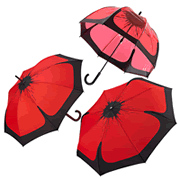
Copyright © https://www.greatwar.co.uk All rights reserved.
http://www.greatwar.co.uk/article/remembrance-poppy.htm
| 9 years ago. Rating: 9 | |
Both measure 42.5mm and are powered by the new automatic El Primero 3652. It brings a big date and flyback function to the well-known El Primero 3600 caliber and still beats at 5 Hz with 60 hours of power reserve. Zenith says link the big date function has an instantaneous jump taking just 0.02 seconds for each link disk to jump and stabilize. We don't yet have more information about this new movement but look link forward to asking Zenith questions about it during our meeting at Watches amp Wonders.
| 5 months ago. Rating: 0 | |

 terryfossil 1
terryfossil 1


 country bumpkin
country bumpkin
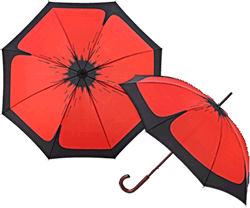
 ROMOS
ROMOS

 bulletman
bulletman
 nomdeplume
nomdeplume
 yoninaisokec
yoninaisokec




